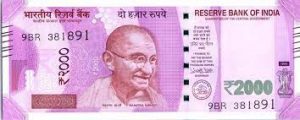RBI Currency Notes In Circulation: In the cultural heritage of a country money plays a significant role in mirroring its socio-economic history. The Reserve Bank has the sole authority to issue banknotes in India. The Reserve Bank, like other central banks the world over, changes the design of banknotes from time to time. Reserve bank of India’s currency management department located at central office mumbai is the core statutory function of note and coin issue and currency management. The demand for RBI Currency notes in circulation and the demand for fresh notes and coins is the function of the currency department. Also placing the indent with four printing presses and mints, receiving supplies against those indents and distributing them through the 18 offices of the Bank, a wide network of currency chests, repositories and small coin depots. Section 22 of the RBI Act gives the currency issuer authority to the RBI. Currency chests are branches of selected banks authorized by the RBI to stock rupee notes and coins. Check details of RBI Currency Notes In Circulation available here.
Indian Currency Notes History: 1770-1998
- The history of paper money used nowadays traces its origins to the late eighteenth century with the issues of private banks as well as semi-government banks (the Bank of Bengal, the Bank of Bombay and the Bank of Madras alluded to as the Presidency Banks).
- The Paper Currency Act of 1861 conferred upon the Government of India the monopoly of Note Issue bringing to an end note issues of Private and Presidency Banks.
- The Government of India continued to issue currency notes till the Reserve Bank of India was established on 1st April, 1935.
- When the one rupee note was reintroduced as a war time measure in August, 1940, it was issued by the Government of India with the status of a coin. The Government of India continued to issue Rupee one notes till 1994.
- The motifs appearing on Indian currency notes reflect the changing socio-cultural ethos and the world-view of the times: buccaneering mercantilism, colonial consolidation, domineering imperialism, the grandeur of empire, to the symbols of National Independence followed up by allegories of progress and finally in the latest series, reminiscing Gandhian values.
Access Our New Bundle PDF – For Current Affairs 2022
RBI Currency Notes In Circulation
Currency in circulation (CiC) includes banknotes and coins. Presently, the Reserve Bank issues banknotes in denominations of Rs.2, Rs.5, Rs.10, Rs.20, Rs.50, Rs. 100, Rs. 200, Rs. 500 and Rs. 2000.
RBI Currency Notes Features – RBI Currency Notes In Circulation
| Image | Note
(Rs) |
Dimension
(Cms) |
Color | Motto |
 |
1 | 9.7 * 6.3 | Pink Green | Sagar Samrat |
 |
10 | 63 * 123 | Chocolate Brown | Konark Sun Temple |
 |
20 | 63 * 129 | Yellow Greenish | Ellora Cave |
 |
50 | 66 * 135 | Fluorescent Blue | Hampi With Chariot |
 |
100 | 66 * 142 | Lavender | Rani Ki Vav |
 |
200 | 66 * 146 | Bright Yellow | Sanchi Stupa |
 |
500 | 66 * 150 | Stone Grey | Red Fort |
 |
2000 | 66 * 166 | Magenta | Mangalyaan |
Contemporary Currency notes have 15 languages on the panel which appear on the reverse of the note. The denomination is written in English and hindi. The languages are displayed in alphabetical order. Languages included on the panel are assamese, bengali, gujarati, kannada, kashmiri, konkani, malayalam, marathi, nepali, odia, punjabi, sanskrit, tamil, telugu and urdu.
Current Affairs 2022 – Daily, Weekly, Monthly
RBI Currency Notes Printing Press
The Department of Currency Management (DCM) receives notes from four currency note printing presses. Two of the currency note printing presses are owned by the Government of India and two are owned by the Reserve Bank, through its wholly owned subsidiary, the Bharatiya Reserve Bank Note Mudran Ltd. (BRBNML).
The government owned presses are at,
- Nasik (Western India) and
- Dewas (Central India)
The other two presses are at,
- Mysore (Southern India) and
- Salboni (Eastern India)
Functions Of RBI Currency Management Department: RBI Currency Notes In Circulation
The Department addresses policy and operational issues relating to,
- Designing of banknotes
- Forecasting demand for notes and coins
- Ensuring smooth distribution of banknotes and coins throughout the country and retrieval of unfit notes and uncurrent coins from circulation
- Ensuring the integrity of bank notes
- Administering the RBI (Note Refund) Rules
- Reviewing/rationalizing the work systems/procedures at the issue offices on an ongoing basis and
- Dissemination of information on currency related matters to the general public.
RBI Currency Coins In Circulation
Coins are minted in four mints owned by the Government of India. The mints are located at Mumbai, Hyderabad, Calcutta and Noida. RBI Currency coins in circulation are Rs. 1, Rs. 2, Rs. 5, Rs. 10. The Government of India can issue any denomination coin but not exceed Rs.1000, as per the coinage act 2011, (1906).
- Highest denomination in circulation – Rs.10
- Lowest denomination in circulation – Rs.1
FAQs – RBI Currency Notes In Circulation
Q. What are the RBI Currency notes in circulation?
The RBI Currency notes in circulation are Rs.2, Rs.5, Rs.10, Rs.20, Rs.50, Rs. 100, Rs. 200, Rs. 500 and Rs. 2000.
Q. What is the highest denomination in circulation of the RBI Currency coins?
The highest denomination in circulation of the RBI Currency coins is Rs.10.
Q. What is the lowest denomination in circulation of the RBI Currency coins?
The lowest denomination in circulation of the RBI Currency coins is Rs.1.
Current Affairs Package ( 1 Year Validity ) – Click Here All in One – 1 Year Subscription – Click Here Banking Awareness Video Course – Click Here Insurance Awareness Video Course – Click Here







Current notes with image would be useful for quick glance
Now added ma
The perfect notes to revise annna..neraiya pictures and colourful ah irunthaa innum padika aasaiyaa iruku anna..thank u for making this!🥰💙